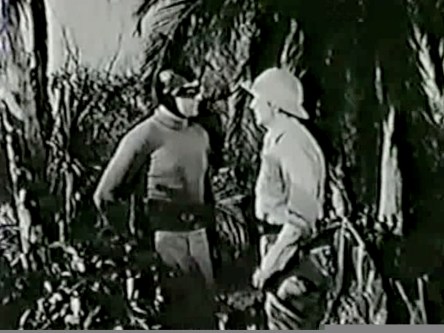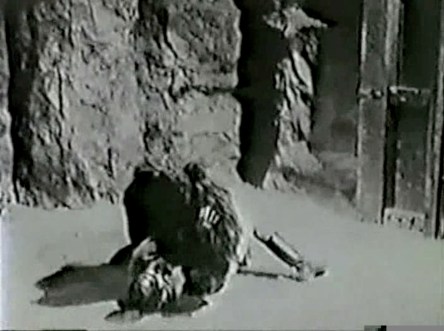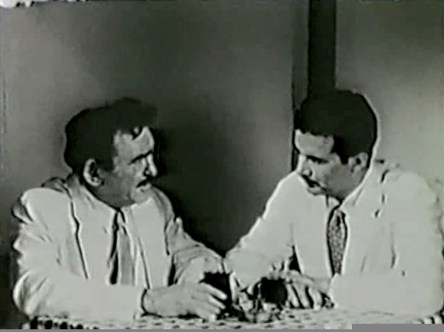
On the docks of a seaport close to a Near Eastern jungle, Ted Arnold watches animal trapper Nat Coleman loading crates of live leopards and other animals onto a ship. Suddenly, a cable snaps, and a heavy load crashes to the dock! Suspecting foul play, Ted spies an Arab workman panic and run away from the scene, and follows him into the city. Tracking the suspicious dockhand to a house and confronted by a beautiful woman, Ted is surprised when Nat Coleman himself, the man’s employer, catches up to them and vouches for his workman. The Arab’s name is Omar, and he has been an employee of Coleman’s since stumbling out of the jungle, haunted by a fear he refuses to name. In this instance, he ran because he thought the men who sought his life had intended for the sabotaged crate to fall on him. Trusting Coleman’s word but eager to discover Omar’s secret, Ted gladly accepts Coleman’s invitation to be a guest at his jungle compound. This is but his first step into a tangled web of international intrigue that involves a dethroned Caliph, a subversive foreign plot to enslave the jungle tribes, and even an alliance with the secretive guardian of the jungle himself, Captain Africa!

In the age of Black Panther (or really any time in the last fifty years or so), the idea of a white hero calling himself “Captain Africa” sounds comically tone-deaf, but we have already encountered African-set “white savior” heroes in the serials, and this one follows a long tradition. The heroism of Captain Africa, “a strange being whom the natives fear, yet worship” (Chapter One), is an example of the “white man’s burden,” living in the jungle, settling disputes, and (most importantly) protecting the innocent tribes of the area from outsiders who might exploit them, and nobly asking for nothing in return (except the tribes’ absolute deference, of course). As such he is instantly recognizable as a thinly-veiled gloss on the Phantom, the long-running comic strip hero created by Lee Falk, and who had starred in a Columbia serial twelve years earlier. Rather than pay to license the character from King Features again (as one of the very last theatrical serials ever produced, Captain Africa was made long after the era in which studios spent much money on them), Columbia instead created their own version of the jungle guardian, his gaudy honorific an alias for an alias. (Columbia wasn’t the only studio to play this game: Republic had “Don Daredevil” replace Zorro, for example.)

It had been a while since I watched The Phantom, so I went back through my old notes to compare the two serials. Let’s see: the Phantom is attacked by a lion; Captain Africa is attacked by a lion. The Phantom is almost crushed by a portcullis, only to roll out of the way just in time; Captain Africa is almost crushed by a portcullis, only to roll out of the way just in time. The Phantom fights a gorilla; Captain Africa . . . hmm, I’m starting to see a pattern here. For the most part, Captain Africa’s costume is different enough from the Phantom’s to avoid confusion (or litigation) up close. It sort of looks like the Phantom costume you might throw together at the last minute for a Halloween party: instead of a skin-tight bodysuit, he wears a jersey and breeches. Captain Africa’s headgear resembles one of those old-time leather football helmets, and paired with goggles, well, the original Phantom could probably count on his lookalike to run errands in his place on dark nights. At the same time, when compared side by side, the shots from the two serials are clearly different: it is the plot points that are recycled, not the scenes of the Phantom in action. (See the comments below regarding the conflict over rights, which goes a long way toward explaining why whole scenes might have been filmed, only to be cut into the stingiest flashbacks.)

The way the title characters are presented in their respective serials is also different: The Phantom is told from the hero’s point of view, beginning with the death of the old Phantom and covering his son’s assumption of the hero’s name and identity (one of the conceits of the Phantom being that it is a persona adopted by generations of fathers and sons, making it seem as if he were a single immortal being). The main protagonist of Captain Africa, however, is Ted Arnold (Rick Vallin), covert operative for a secret, unnamed organization; Captain Africa (John Hart) appears in every chapter, sometimes briefly and sometimes extensively, but he is at first an unknown quantity, a sort of guest star in his own movie, and once Ted wins the confidence of Omar and his displaced Caliph, he must convince Captain Africa to join in the project of restoring the Caliph to his throne. (We eventually learn Captain Africa’s backstory, and it is similar to Ted’s: after a heroic wartime career, under orders from his superiors he assumed the identity of Captain Africa and convinced the natives of his “magical” power in order to keep the peace in the region–there is no hint of a multi-generational tradition.)

So, playing along, what does happen in Adventures of Captain Africa? Working with Nat Coleman (Bud Osborne), Ted follows Omar (Ben Welden) to a rendezvous with the exiled Caliph (Paul Marion), who relates the story of his overthrow by a usurper only referred to as “the tyrant.” The Caliph, Abdul al-Hamid, and his daughter, Princess Rhoda (June Howard)–exoticism only goes so far, I guess–escaped to live as nomads in the desert with a handful of loyal retainers, avoiding the bands of outlaws and slave traders that rule the desert, as well as patrols by the tyrant’s guards. There they await the opportunity to return to their homeland and return Hamid to his throne. (All of this is conveyed by voiceover accompanied by stock footage from desert swashbuckling epics.)

Ted is convinced that Hamid, in addition to being the rightful Caliph, would be a force for peace in the region. With the help of Captain Africa (who, in a parallel story, works to prevent subversives from provoking a rebellion among the jungle tribes–the same subversives who are in league with the tyrant who dethroned Hamid), Ted convinces Omar to break his vow of silence since they already know all about Hamid’s position, and presents himself as an ally. From then on, Ted, Omar, and Captain Africa work together on the Caliph’s behalf (Nat Coleman retires from the action to continue running his business once the alliance is cemented), seeking loyalists in the tyrant’s capital city and fighting off the subversive elements who would seek to enslave both the jungle tribes and the Arabs of the desert.

The resulting adventure is a mélange of Arabian Nights-style swashbuckling and jungle adventure: despite taking place in 1955, Adventures of Captain Africa feels much older. Of course the reliance on stock footage is a big part of that, but the typical avoidance of specific politics is another. My guess is that the unnamed political organization for which Ted Arnold works is meant to be the CIA, and the similarly unnamed subversives who promise freedom to the jungle natives but who, Ted warns, have enslaved every other population they have come in contact with, are meant to represent Soviet communism, and both the tribes and the Caliph’s people are a football tossed between them. But really, all you need to know is that there are good guys and bad guys. The various people of the desert wear traditional caftan and burnous, ride horses, and fight with wicked, curved scimitars; the jungle tribesmen are the kind of loincloth-clad, spear-throwing savages typically depicted in jungle movies. Only the white men use guns. In short, it takes place in serial never-neverland, and a more simplified version of it than most.

The reliance on stock footage and voiceover has a distancing effect, as well. In the best serials, editing and camera work give the action a thrilling immediacy, a feeling that you are there, watching or participating in the scene. From the first chapter, however, when Nat Coleman describes his first meeting with Omar and several mysterious incidents of sabotage to Ted, the tone is one of rambling digressions and things that happened in the past or to other people, with frequently thin narrative reasons for including one scene or another, except, of course, for the fact that the footage is on hand. (It doesn’t help that Coleman isn’t the most dynamic narrator, and it’s a relief when, after a few chapters, he disappears from the story.) The serial that I was most reminded of was not The Phantom, but The New Adventures of Tarzan, from twenty years before.

A few of these scenes are interesting from a technical perspective, including the use of rear projection to insert Coleman or other characters into the foreground of the old footage, as in Coleman’s flashback to a lion attack in his own bedroom. Even when the action shifts to the present, the early chapters are full of jungle business inserted so that Ted and Coleman have something to point out and talk about while they walk from one location to another: various animals, the daily routine of a rubber plantation, a police raid on a riverboat carrying contraband rubber. Coleman explains that there has been a campaign of rubber theft by well-organized gangs. “Do you suppose your unknown enemies are involved in it?” Ted asks, to which Coleman replies, “If they are, I wish they’d stay with it and leave me alone,” acknowledging that these scenes are nothing more than padding. As always, there is something magical in the way whole worlds can be stitched together out of unrelated footage, but Captain Africa shows that you can only stretch leftovers so far before they go stale.
What I Watched: Adventures of Captain Africa (Columbia, 1955)
Where I Watched It: Captain Africa was among the bootleg DVDs I bought and went through a few years ago, but for whatever reason I didn’t get around to watching this one until now. However, the transfer was quite poor indeed, full of missing frames and even whole scenes. Luckily for me, the whole serial was on YouTube in better (although still not pristine) quality.

No. of Chapters: 15
Best Chapter Title: What Captain Africa lacks in originality, it makes up in exclamation points: every chapter title ends with a bang (as does the serial’s subtitle, “Mighty Jungle Avenger!”)! So whether Ted and company face a “Midnight Attack!” (Chapter Three) or “Slave Traders!” (Chapter Six), writer George H. Plympton and director Spencer G. Bennet are sure to extract as much excitement out of the situation as possible. Several chapter titles refer to the “Mystery Man of the Jungle!” (Chapter One) himself, and of those my favorite is Chapter Nine’s, “Blasted by Captain Africa!” (emphasis in original).

Best Cliffhanger: Many of the cliffhangers are not set up especially well, so they end their chapters abruptly, and they frequently suffer from the same murkiness that makes much of the serial’s action sequences so hard to follow. In addition, the feeling of going through the motions–hitting familiar perils such as animal attacks, fire, falls, and cave-ins–is readily apparent. However, there are a few sharp, well-executed, and interesting cliffhangers in the last few chapters (they must have saved the best for last). At the end of Chapter Twelve (“Fangs of the Beast!”), Captain Africa, exploring the caverns underneath the Caliph’s city, is trapped in a cell with an angry gorilla–a gorilla who, we later find out, carries a key for safe passage through the city around his neck (the “key” is a narrative repurposing of the last piece of the map to the lost city of Zoloz in the original Phantom serial). The subsequent battle is more of a choreographed fight than we have seen so far, and the chapter ends with the gorilla on top of Captain Africa, strangling the life out of him. (After turning the tables on the gorilla and escaping in the next chapter, Captain Africa modestly explains to Ted and Omar that despite appearances, captivity had made the gorilla fat and lazy: “Otherwise, I never could have beaten him.”)

Sample Dialogue: In Chapter One, a fight has broken out in a dockside watering hole.
Ted Arnold: What’s it all about?
Nat Coleman: Who knows? Perhaps nothing. Then again, it might be over something that threatens the peace of the world.

What Others Have Said: “It was over ten years before Columbia considered making a sequel to The Phantom. By this time, [producer] Sam Katzman was in charge of serials, and he was making them cheaper than anybody had ever produced union-made theatrical movies. One story has it that Katzman’s company had actually begun filming the serial before negotiations with King Features, owners of The Phantom comic strip, were completed. In any case, either before or during the production, the King Syndicate wanted too much money, and The Phantom could not be used again on the screen. At least, not exactly.” –Jim Harmon and Donald F. Glut, The Great Movie Serials
(Interestingly, while Harmon and Glut claim that Captain Africa included numerous reused shots of Tom Tyler’s Phantom, they also note that at the time of writing their book, 1972, the 1943 Phantom serial had not been available to view for many years. With the distance in time, it was surely easy to believe that the shots were identical.)
What’s Next: In two weeks I’ll return with a look at one of several serials with animal heroes: The Adventures of Rex and Rinty!